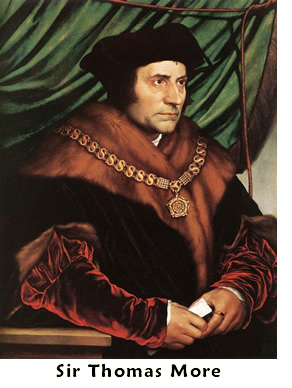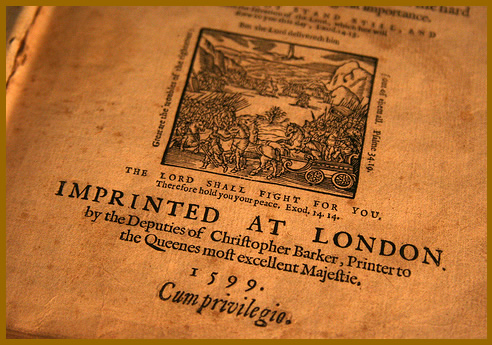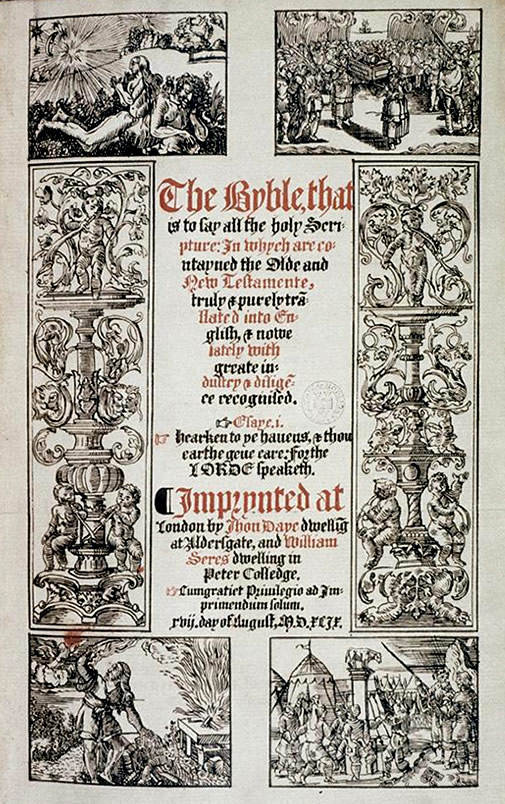 |
From a first edition of 1611
Enduring the Test of Time:
A Milestone Anniversary
For the Authorized Version
By Ron Fritze from Athens, Alabama
Posted on May 1, 2011
History is full of anniversaries. Just now the American Civil War is approaching its 150th anniversary with all the attendant hoopla. A more sedate anniversary in 2011 recognizes the 400th year since the publication of the King James Bible, also known as the Authorized Version. For some of us, the King James Bible has as much, or possibly even more world historical significance than the bloody drama of the War Between the States.
In our postmodern age, we take the Bible for granted in a number of ways, even among strongly religious people. Bibles are readily and inexpensively available to us. As I sit in my study working, there are six Bibles visible. One is Oxford’s Complete Parallel Bible, which consists of four different translations of the Bible into English. My King James Bible is an old student Bible from parochial school. It was my primary Bible from second grade through high school, so it shows all the earmarks of having been used a lot with dog-eared pages and a perilously loose hinge on one of the covers. No matter how beat up that Bible is, it sustains a connection to my childhood and my school days, and I keep it with me for that very reason. After high school, I graduated to an Oxford Annotated Revised Standard Version for my college studies.
A Rare and Arcane Book
For the Rich and the Elite
Bibles weren’t always so available. Medieval manuscript Bibles are works of art, and rare — a single Bible took a team of scribes a year to produce. The text was Latin, the Vulgate translation of St. Jerome, so if you did not read Latin, you did not read the Bible. It was a holy work for the very rich and the educated elite of the clergy.
Parts of the Bible were translated into Anglo-Saxon but not the complete Bible, a pattern that continued into the twelfth and thirteenth centuries. Gradually, bits and pieces of the Bible were translated into Middle English. The Psalms were especially popular as translations.
In the late fourteenth century, the Lollard followers of the renegade theologian John Wycliffe produced two translations of the Bible into the Middle English of Geoffrey Chaucer’s era. The first translation of about 1382 was extremely literal, which also meant it was often difficult to comprehend. As a result, a second translation appearing about 1395-96 sought to transform the sense of the Biblical languages into palatable English.
The Prevailing Attitude
Favored Exclusion and Suppression.
Unfortunately, the medieval English Church considered the Lollards to be vile and dangerous heretics. Among the leaders of the Church, the threat posed by Lollard translations of the Bible tainted the idea of a popular English translation. Thomas Arundel, the Archbishop of Canterbury, called a meeting of the English clergy to condemn Lollardy in the Constitutions of Clarendon of 1408. One of
 its provisions forbade people to translate or even read a vernacular Bible without the permission of their local bishop. This attitude prevailed in England into the early sixteenth century and was exemplified by the religious conservative Sir Thomas More — an attitude of exclusion and suppression peculiar to the British Isles. Other European religious leaders of the time weren’t so doctrinaire as their English brethren.
its provisions forbade people to translate or even read a vernacular Bible without the permission of their local bishop. This attitude prevailed in England into the early sixteenth century and was exemplified by the religious conservative Sir Thomas More — an attitude of exclusion and suppression peculiar to the British Isles. Other European religious leaders of the time weren’t so doctrinaire as their English brethren.
Sir Thomas More may have opposed the proliferation of English Bible, but the times were against him. The invention of the printing press made it easy to produce books quickly, cheaply, and in far greater numbers than was possible by hand-copying a manuscript book. The humanistic scholarship of the Renaissance era also greatly improved the quality and quantity of knowledge about the Biblical languages. Fine dictionaries and grammars of the Biblical languages were written and fine editions of the Biblical manuscripts were put into print.
It Was a Success,
But He Died for It.
The Englishman who led the way in the translation of the Bible was William Tyndale (c1494-1536), who managed to master both Greek and Hebrew. When in 1523 English church authorities rejected his proposal to translate the Bible into English, an English merchant named Humphrey Monmouth stepped forth to provide the needed financial support. Traveling to Germany in 1524 to find a printer, Tyndale brought out his first translation of the New Testament into English in 1525. There was a ready market for Tyndale’s Bible, which was reprinted in 1526, 1530, and 1534. He also continued to improve his translation and brought out corrected editions in 1534 and 1535. Tyndale also provided a translation of a substantial section of the Old Testament, beginning with Genesis and extending through Second Chronicles. The translation of the Old Testament was completed by his associate George Joye.
Title page of a Tyndale Bible
Avoiding Latinate language and style, Tyndale translated the Bible into the colloquial English of his day. His style employed a happy voice and a vigorous narrative, making Tyndale’s translation readable and very popular. However, from the point of view of the authorities, Tyndale’s work was evil because it adopted a vocabulary that backed the burgeoning Protestant Reformation. A Lutheran, or at the least a Lutheran sympathizer, he was betrayed into the hands of ecclesiastical officials in Antwerp, where he was tried for heresy and burned at the stake on 2 October 1536.
A Bible Intended
For the Common Man
Other Bibles based on Tyndale’s translation followed, including the Great Bible of 1539, sponsored by the minister of Henry VIII, the reform-minded Thomas Cromwell. The great successor of Tyndale’s Bible was the Geneva Bible. When Mary I came to the throne in 1553, she tried to re-Catholicize her kingdom. As a result, many Protestant English went into exile.
In 1557, one of those exiles, William Whittingham, who was living in Geneva, Switzerland, produced a translation of the New Testament based on Tyndale. He was joined by Anthony Gilby and Thomas Sampson, and together in 1560 they brought out a complete translation of the Bible known as the Geneva Bible. It was a Bible meant to be read by regular people. The text included helpful headnotes and marginal notes of a stout Calvinistic flavor to explain the text.
 The Geneva Bible was printed in easy to read Roman typeface and produced in quarto-sized volumes suitable for individual reading and study. It was also the first English Bible to divide chapters into verses for easier reference. These features made the Geneva Bible the Bible of choice in English households. The leaders of the Church of England did not approve of the radically Calvinistic Geneva Bible, so they brought out their own translation, the Bishops Bible, in 1568, but it never managed to blunt the popularity of the Geneva Bible.
Official disapproval of the Geneva Bible continued for some time. John Whitgift, archbishop of Canterbury (1583-1604), went so far as to formulate a draft act for parliament authorizing yet another translation, but nothing came of this plan. So things remained in a textual stasis until the death of Queen Elizabeth I in 1603.
The Work Begins.
Elizabeth’s successor was James VI of Scotland, who became James I of England. One of James's first acts as king of England was to comply with the clergy's call for a conference to settle religious differences between radicals and conservatives. The Hampton Court Conference took place in January 1604, and among the many proposals discussed was the call for a new English Bible. John Rainolds,
 the radical president of Corpus Christi College, Oxford, put forth the proposal with the goal of eliminating citations of insufficiently Protestant translations of the Bible used in the Book of Common Prayer. Some conservatives like Richard Bancroft, who was soon to obtain the See of Canterbury, were suspicious of the plan, but James I seized on it as an opportunity to displace the Geneva Bible.
the radical president of Corpus Christi College, Oxford, put forth the proposal with the goal of eliminating citations of insufficiently Protestant translations of the Bible used in the Book of Common Prayer. Some conservatives like Richard Bancroft, who was soon to obtain the See of Canterbury, were suspicious of the plan, but James I seized on it as an opportunity to displace the Geneva Bible.
By 30 January 1604 James and Bancroft had chosen teams of translators, and by 22 July the king officially appointed fifty-four men to carry out the work, although only forty-seven actually served. These were among the finest scholars of biblical languages in England and included the entire spectrum of English Protestantism from radical to conservative: Lancelot Andrewes, John Rainolds, Laurence Chaderton, Sir Henry Savile, and Hadrian Saravia. Not every great scholar participated, however — the brilliant but cantankerous Hebraist Hugh Broughton was not even invited. The translators were divided into six companies. Two met at Westminster and translated Genesis to II Kings and Romans to Jude, respectively; two at Oxford were responsible for Isaiah to Malachi and the Gospels, Acts, and Revelation; and two at Cambridge handled I Chronicles to Ecclesiastes and the Apocrypha.
Their instructions confirmed the conservative direction of the enterprise. They were to base their translation on the Bishops' Bible rather than the Geneva Bible whenever possible. Traditional English terminology for church matters was to be utilized rather than the innovative vocabulary favored by radical Protestants; for example, church was to be used rather than congregation. Marginal notes were to be limited to philological explanations and variant readings. In this way the controversial and partisan notes of the Geneva Bible were to be avoided.
Steady, Methodical, and Scholarly
Each scholar was to translate his company's whole assignment on his own. Then company members were to meet as a group and produce a text commonly agreed upon. Originally the text produced by each company was to be sent to the other five groups for approval, but that plan was abandoned. Instead, twelve translators — two from each company — met to revise the whole translation. Individual work on the initial translations took about three years, and the meetings to create the final version took another three. Robert Barker, the king's printer, published the finished product in 1611. It included Miles Smith's lengthy and informative preface, "The Translators to the Reader," which explained their methods.
The scholarship embodied in the Authorized Version was good for its day, thanks to the steady advance of linguistic studies during the sixteenth century. But the translation of 1611 suffered because of the translators' dependence on defective original texts in the biblical languages and their inadequate understanding of some aspects of ancient Hebrew. Although the Bishops' Bible was supposed to serve as the model for the new version, the translators made extensive use of the Geneva Bible and the Rheims New Testament, the latter a translation produced by English Roman Catholic exiles, which served as the source for much of the Authorized Version's Latinate English.
To modern ears, the King James Bible has an archaic ring with its thees and thous, smiteths and saiths. Actually, the King James Bible had an archaic ring to the ears of people in 1611. That its English was old-fashioned should not be all that surprising — the translators used the fifty-year-old Geneva Bible extensively, and it was source based for the most part on the eighty-year-old translation by William Tyndale.
The Authorized Version was far more successful than the Bishops' Bible, though it took a generation to supplant the hardy Geneva Bible, whose final (and at least 140th) edition appeared in 1644. That success was helped along by some government restrictions on the production of Geneva Bibles, so the playing field was not quite level. In fact, the Geneva Bible retained some unexpected fans in high places. The Authorized Version translator and proto-Arminian bishop of Winchester, Lancelot Andrewes, continued to use the Geneva Bible in preparing sermons, as did William Laud, Charles I's steadfastly Arminian archbishop of Canterbury, during the 1630s.
Not surprisingly the irascible Hugh Broughton attacked the Hebrew scholarship of the Authorized Version. None of these roadblocks could stop the Authorized Version from becoming the premier English Bible. Its masterful prose, eminent suitability for public reading, and its non-partisan Protestantism ensured unprecedented popularity. Some of the more zealous adherents of the King James Bible rather unbiblically consider it to be a divinely inspired translation — the only divinely inspired translation. The King James Only movement of the late twentieth and early twenty-first centuries is the premier example of this phenomenon.
The King James Bible has been challenged but never entirely superseded by the Revised Version (1885), the Revised Standard Version (1952), the New English (1970), the Revised English (1989), the New Revised Standard Version (1989), and the English Standard (2001) Bibles.
For further reading:
 Benson Bobrick, Wide as the Waters: The Story of the English Bible and the Revolution It Inspired, 2002.
Benson Bobrick, Wide as the Waters: The Story of the English Bible and the Revolution It Inspired, 2002.
 F. F. Bruce, History of the Bible in English, 3d ed., 1978.
F. F. Bruce, History of the Bible in English, 3d ed., 1978.
 Gordon Campbell, Bible: The Story of the King James Version, 1611-2011, 2011.
Gordon Campbell, Bible: The Story of the King James Version, 1611-2011, 2011.
 S. L. Greenslade, ed., The West from the Reformation to the Present Day, Vol. 3 of The Cambridge History of the Bible, 1963.
S. L. Greenslade, ed., The West from the Reformation to the Present Day, Vol. 3 of The Cambridge History of the Bible, 1963.
 Christopher Hill, The English Bible and the Seventeenth-Century Revolution, 1995.
Christopher Hill, The English Bible and the Seventeenth-Century Revolution, 1995.
 Alister McGrath, In the Beginning: The Story of the King James Bible and How It Changed a Nation, a Language, and a Culture, 2001.
Alister McGrath, In the Beginning: The Story of the King James Bible and How It Changed a Nation, a Language, and a Culture, 2001.
 Adam Nicolson, God’s Secretaries: The Making of the King James Bible, 2003.
Adam Nicolson, God’s Secretaries: The Making of the King James Bible, 2003.
 David Norton, The King James Bible: A Short History from Tyndale to Today, 2011.
David Norton, The King James Bible: A Short History from Tyndale to Today, 2011.
 A. W. Pollard, ed., Records of the English Bible: The Documents Relating to the Translation and Publication of the Bible in English, 1525-1611, 1911, rprt. 1974.
A. W. Pollard, ed., Records of the English Bible: The Documents Relating to the Translation and Publication of the Bible in English, 1525-1611, 1911, rprt. 1974.

Click on the black panther to read about Ron Fritze's latest book,
Invented Knowledge: False History, Fake Science, and Pseudo-religions. |
 |















 |
 |





 its provisions forbade people to translate or even read a vernacular Bible without the permission of their local bishop. This attitude prevailed in England into the early sixteenth century and was exemplified by the religious conservative Sir Thomas More — an attitude of exclusion and suppression peculiar to the British Isles. Other European religious leaders of the time weren’t so doctrinaire as their English brethren.
its provisions forbade people to translate or even read a vernacular Bible without the permission of their local bishop. This attitude prevailed in England into the early sixteenth century and was exemplified by the religious conservative Sir Thomas More — an attitude of exclusion and suppression peculiar to the British Isles. Other European religious leaders of the time weren’t so doctrinaire as their English brethren.

 the radical president of Corpus Christi College, Oxford, put forth the proposal with the goal of eliminating citations of insufficiently Protestant translations of the Bible used in the Book of Common Prayer. Some conservatives like Richard Bancroft, who was soon to obtain the See of Canterbury, were suspicious of the plan, but James I seized on it as an opportunity to displace the Geneva Bible.
the radical president of Corpus Christi College, Oxford, put forth the proposal with the goal of eliminating citations of insufficiently Protestant translations of the Bible used in the Book of Common Prayer. Some conservatives like Richard Bancroft, who was soon to obtain the See of Canterbury, were suspicious of the plan, but James I seized on it as an opportunity to displace the Geneva Bible.